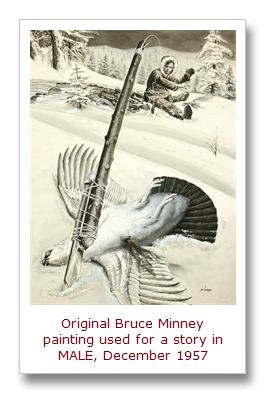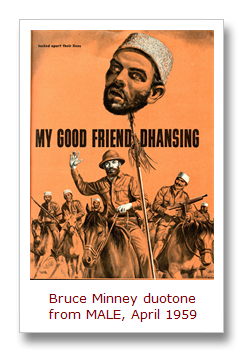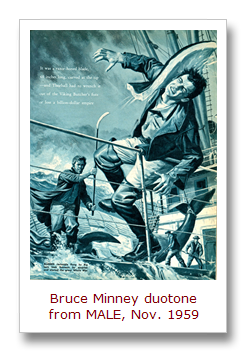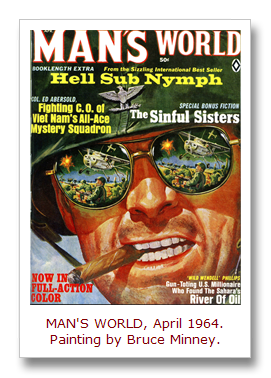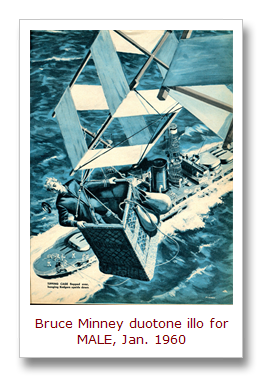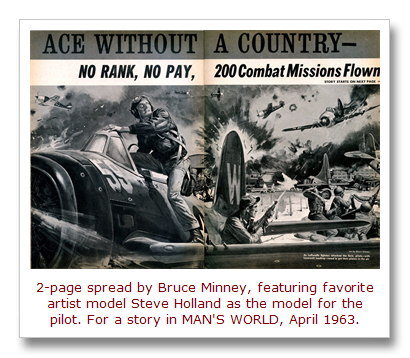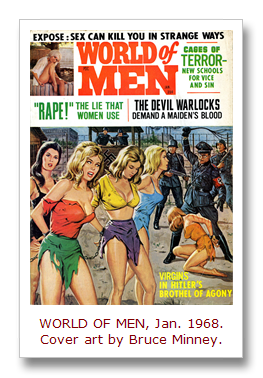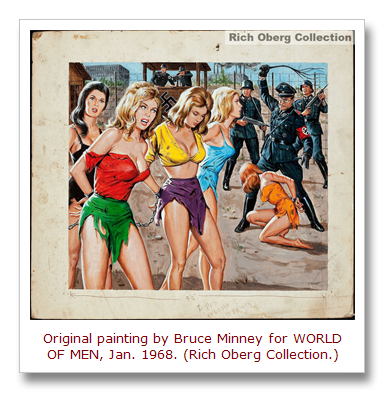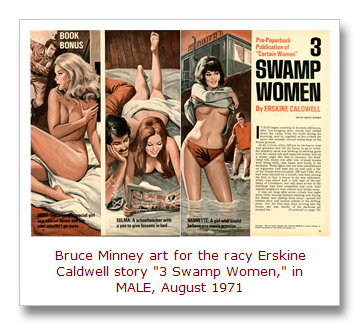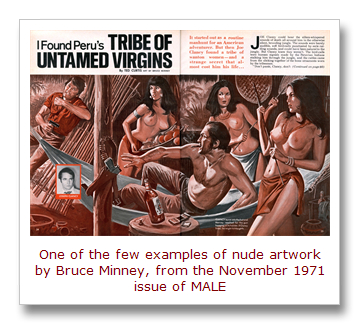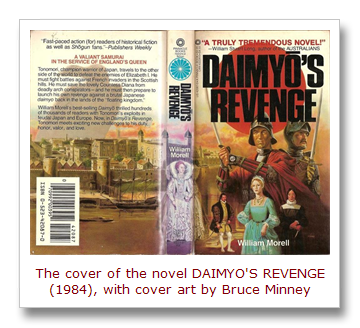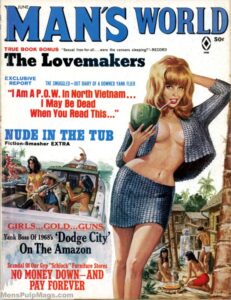
Bruce Minney is one of the most talented and prolific of the many great artists who created cover paintings and interior illustrations for men’s adventure magazines from the mid-1950s to the mid-1970s.
He’s not as widely known as some of the artists associated with the men’s pulp mag genre, such as Mort Kunstler, Basil Gogos, Gil Cohen, James Bama or Norman Saunders.
But he certainly deserves wider recognition.
Until recently, I knew very little about Bruce other than what’s in the brief bio included in Adam Parfrey’s book It’s a Man’s World: Men’s Adventure Magazines, The Postwar Pulps.
It says: “Bruce Minney — A commercial artist who contributed to the Martin Goodman line [STAG, MALE, MEN, FOR MEN ONLY, etc.] as well as other publishers in the field in the fifties and early sixties, Minney excelled at historical subjects. He produced scores of paperback covers, with an emphasis on westerns and historical adventures, before retiring to become a fine-arts ceramicist.”
Contrary to what that thumbnail bio said, I knew that Minney had actually continued doing artwork for men’s adventure magazines into the mid-1970s.
But I didn’t know much more about him — or if he was still alive.
Then, a few weeks ago, I got an email from Bruce’s son-in-law, Tom Ziegler, husband of Bruce’s daughter Carole.
Tom had been looking around the Internet to see what was out there about Bruce and had noticed one of the recent posts I’d done about Bruce’s work here on MensPulpMags.com.
Tom told me Bruce was alive and well and living in Florida. He said Bruce was now retired from his second career as the creator of award-winning ceramic art and pots and was back to doing some painting again.
I asked Tom if he thought Bruce would be willing to do a phone interview with me. He said ‘yes,’ and graciously set it up.
A few days later I had the great pleasure of talking with Bruce Minney — one of my favorite artists.
Today, I’m posting the first of several posts that will provide a transcription of our conversation.
I started by asking Bruce where he was born and raised.
BRUCE: I was born in 1928 in Oakland, California. I grew up there and got married there to my high school sweetheart, Doris, and we had our daughter Carole there.
Did you go to an art school after high school?
BRUCE: Yes, I studied art at The California College of Arts and Crafts, which was near Berkeley. It’s now a campus of Cal U. They made it a university campus after I left. When I went there it was independent. I graduated from art school around 1950.
Did you focus on illustration art there?
BRUCE: Not at all. I wanted to be a fine artist. I wanted to sell paintings in galleries. But after four years, I realized it was very hard to make a living as a fine artist. So, I took a course at night on illustration. I did that for a year. There was a guy I met there who worked for an agency over in San Francisco, an art firm. All they did was art for advertising. Very commercial stuff, like drawing the ellipses on mayonnaise jar labels and that kind of thing. I remember he took four of us to his agency to evaluate our skills. But I guess I wasn’t good enough at drawing ellipses. [He laughs.] The other three guys got hired but not me. Of course, that turned out to be a good thing. I didn’t really want to be in that type of commercial art business anyway.
Is that when you decided you wanted to become an illustration artist?
BRUCE: Yes, but first I worked as a fireman. I was a fireman in Orinda, California for about three years. It was a good job for me at the time, because I worked one day and got two days off, so I had time to work on my art samples. You need samples when you want to become an illustrator. You go the art directors and show them your samples. And, if they like them, they’ll hire you for a job. So that’s how I spent my free time when I was a fireman in California.
When did you head to New York and hook up with the men’s adventure magazine publishers there?
BRUCE: That was in 1955. My wife, Doris, and I put all of our possessions in the Plymouth, along with our 4-year-old daughter Carole, and drove to New York City.
A lot of the great illustrations artists lived in New York back then because that’s where most of the major magazine and book publishers had their offices. Is that why you picked New York?
BRUCE: Yes, I wasn’t sure I was going to get any illustration work there. But I wanted to try, so I went around and showed my samples to the art directors at various publishers and I finally got my first illustration job with Magazine Management, Martin Goodman’s company.
The art director there was Larry Graber at that time, right?
BRUCE: Yes, Larry Graber. He came after Mel Blum. I never met Mel.
Larry helped launch the careers of many great illustration artists. A while ago, when I interviewed Mort Kunstler and talked to Gil Cohen, they both told me how much they liked and appreciated Larry.
BRUCE: Yes, Larry was a real great guy.
Mort told me Larry is still alive and living in New York. I’m hoping to do an interview with him eventually.
BRUCE: I was also helped by Eddie Balcourt. You ever heard of him?
Yes. In fact, there was an extensive article about Balcourt and the long list of artists he represented in Issue #32 of ILLUSTRATION magazine last year, written by the pulp art and paperback expert Gary Lovisi. It’s amazing how many great illustration artists Balcourt represented — you, John Leone, Robert Maguire, Rudy Nappi, Lou Marchetti, Bob Schulz, John Duillo and many others.
BRUCE: Yeah, Eddie represented just about everybody. And, he got me a lot of jobs.
How did you meet him?
BRUCE: My wife Doris actually looked him up and met him first. She thought I needed an agent, because I had gone around to the same art directors several times and didn’t get much work. Doris sought out Eddie and put me in touch with him. Eddie Balcourt really knew how to get work for artists. He knew all the art directors and made sure he bought them Christmas presents every year.
He’s still alive, still painting and living in New York now.
BRUCE: Yeah, I hear he’s still teaching some kind of class, watercolors I think. I didn’t know he was an artist at all when he represented me.
Was it Balcourt who got you in the door with Larry Graber at Magazine Management?
BRUCE: Yes, it was.
Do you remember the first assignment Larry gave you?
BRUCE: I do. It was a two-page spread of a hunter sitting on the back of a dead elephant and smoking a cigarette. That was the first one. Actually, I used Eddie Balcourt as the model for the hunter, because I’d just arrived in New York and didn’t know any models yet or any photographers. Eddie took me to see Robert Scott to do the photos. Do you know who he was?
Didn’t he do a lot of glamour girl photography back then?
BRUCE: Yes, and he also shot a lot of photos of models for illustrators. For my first assignment for Magazine Management, Robert Scott and I shot Eddie Balcourt sitting on a chair, which was supposed to be an elephant. And, that was my first job. It was a black-and-white two page spread. I don’t remember which magazine it was for. But Larry Graber must have liked it, because he gave me other work.
Did you do your painting in a studio that Balcourt had?
BRUCE: No. He just represented me. I’d go in and get jobs from him, come home with them and do them at home.
Did you meet publisher Martin Goodman?
BRUCE: No, I never met him, though I used his secretary as a model once. I don’t remember her name.
How about Bruce Jay Friedman, who was an editor at Magazine Management before he became a famous playwright and novelist, or Mario Puzo, who worked there as a writer and assistant editor before he made it big as the author of THE GODFATHER?
BRUCE: No, I never met either of those guys. They were on another floor from Larry, as I recall. But I did meet some of the other artists who worked for the Goodman magazines, like Jim Bama, Rudy Nappi and Charles Copeland. I remember Copeland and I went and had a martini at ten o’clock in the morning once. He liked his martinis.
Did you meet Mort Kunstler?
BRUCE: No, but I remember he called me once. He needed to borrow a book I had about German aircraft. He was doing a painting that had a very obscure German plane. I think it had twelve engines. [NOTE: It was probably a Dornier DO X.] He was doing a cover painting that had that plane in it and I was doing an interior illustration for the same issue. I don’t know where I found the book. It was all in Japanese. But it had one of those planes in there. Mort hadn’t been able to find anything on it anywhere else. So, I loaned him my book. As I recall, I finished my painting for that issue before he had his done.
You and Mort and the other men’s adventure magazine artists painted so many different kinds of people and scenes. Everything from battle scenes and Westerns, to exotic adventure and animal attack scenes, to images of beautiful women, which later came to be called “Good Girl Art.” What did you all use for references?
BRUCE: Well, for one thing, you kept a filing cabinet full of clipped art. You would look through magazines and cut out pictures and file them under some topic. I had files full of old World War II stuff and uniforms and landscapes and mountains and scenes from different countries and girls and all kinds of stuff.
Did you also use reference books from libraries?
BRUCE: Yes, in addition to using things from my files, I would go to the New York Public Library. They also had a picture section there, and you could borrow the pictures. When I had an assignment, I would go through all of the images I could find in my files or at the library, then draw a few sketches of a possible illustration and then take it in to Larry Graber or whichever art director I was working with, and he’d OK it. Then, then I’d shoot models. For men, I used Steve Holland a lot.
It seems like all of the New York illustration artists loved using Steve Holland in the ‘50s, ‘60s and ‘70s. He was the model for hundreds of magazine illustrations back then, especially men’s adventure mags, and for scores of paperback covers — most famously, Jim Bama’s DOC SAVAGE cover paintings, of course.
BRUCE: Yes. He was great to work with. Did you know Steve was a handball addict? He played handball all the time. And, amazingly, he smoked about two or three packs of cigarettes a day.
I didn’t know that. Steve died in 1997. I think he was 72 at the time.
BRUCE: Yeah, I’m surprised he lived so long. I also remember Steve wanted to be an illustrator himself. He used to bring me illustrations he did, his samples. They were pretty good, but he went crazy on the clothing. Too many wrinkles. He painted every wrinkle he saw. I also used Shere Hite as a model.
She was another favorite model of many men’s adventure artists, before she became famous for writing her “Hite Report” books on female and male sexuality.
BRUCE: That’s right. I remember that Shere didn’t care whether she was nude or not, when she posed. Most girls would charge you more to pose nude, but not Shere Hite. She didn’t care. She didn’t seem much interested in anything. Then at one point she started handing out questionnaires on sex to all the guys she met, which she later used for one of the books she wrote.
Did you fill out one of her sex questionnaires?
BRUCE: No, for some reason, she never gave me one. [He laughs.] In fact, I was kinda hurt about that, ‘cause I used her a lot as a model.
Any other models you remember?
BRUCE: Sheba Britt. Spelled B-R-I-T-T. That’s was her stage name, I think. She was also an actress. A soft porn star.
Oh yeah, according to her entry on IMDB, she went by various names in her movies and did quite a few soft porn flicks.
BRUCE: I also used Lisa Karan a lot.
Lisa Karan and Shere Hite were also favorite models of artist Norm Eastman.
BRUCE: They were both beautiful. Lisa had kind of a big honker, but when you looked at her straight on she was great.
I think Lisa may have used other names, too, like Sheba Britt did. I got an email a while ago from a guy who saw a photo of Lisa on my blog and sent me a scan of a cheesecake photo spread in the April 1960 issue of MAN’S DARING that featured a mode who looked just like Lisa Karan, but she was credited as Lisa Kamish. Did you use Robert Scott to take all of your model photos?
BRUCE: Well, eventually I did my own. Using Robert Scott got too expensive. But the artist Rudy Nappi, who also did a lot of illustrations for men’s adventure magazines, taught me how to do my own photos. He belonged to a studio with a bunch of other artists. They didn’t paint there, but they shot their model photos there. One day, I was talking to Rudy about how expensive Scott was getting and he told me I should shoot my own pictures. I said “I don’t know how.” And, he said “I’ll teach you. You ought to develop your own pictures, too.” And, I said I didn’t know how to do that either. He says “I’ll teach you.” And he did, he taught me all that.
That was really a nice thing for him to do.
BRUCE: Yes, it was. I remember another interesting story about Nappi. One day he took the bus into New York. And, as he’s riding along, a guy got on and held up the bus driver and took the bus money. But, unbeknownst to the thief, Rudy took his picture. Then he gave it to the cops and they caught the guy and arrested him.
That’s funny. I’m a big fan of Nappi’s work, too.
BRUCE: I think as the men’s adventure magazines started to decline Rudy did book covers, like I did. A lot of the men’s adventure guys did dust covers for hardback books and cover paintings for paperbacks. Some went on to become famous Western painters, like Jim Bama. I never did Western art, but I did a lot of book covers.
Did Eddie Balcourt get you hooked up with the book publishers?
BRUCE: No, after a few years with Eddie, I got to know a lot of the art directors and publishers and I started representing myself. I did all kinds of book covers. Everything from Harlequin romance covers and Lone Ranger books to the Horatio Hornblower series.
This is the end of Part 1 of my interview with Bruce Minney.
Here’s a link to Part 2. And, here’s a link to Part 3.
UDPATE: After I posted this interview, Tom Ziegler published a terrific, lushly illustrated book about Bruce and his artwork, titled BRUCE MINNEY: THE MAN WHO PAINTED EVERYTHING. It’s a must-have for any fan of men’s adventure magazines.
* * * * * * * * * *
Comments? Corrections? Post them in the Men’s Adventure Magazines Facebook Group.
Related and recommended reading…



